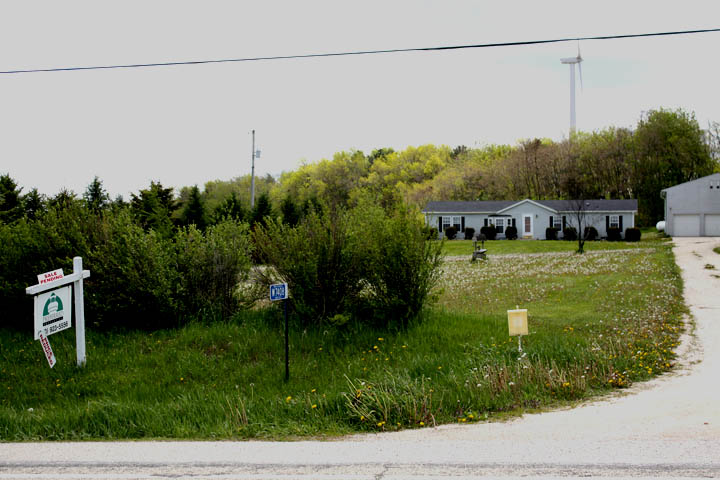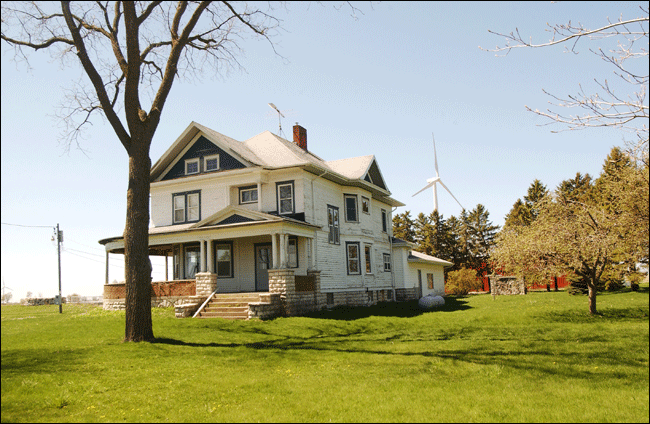9/18/2010: When it comes to reliable renewable energy for the dairy state of Wisconsin, what part of Manure Digester don't you understand?
 NOTE FROM THE BPWI RESEARCH NERD: Though not as noticable or photogenic as a 500 foot tall wind turbine, manure digesters in Wisconsin are reliable, efficient, and solve several serious environmental problems while generating electriciy for surrounding homes.
NOTE FROM THE BPWI RESEARCH NERD: Though not as noticable or photogenic as a 500 foot tall wind turbine, manure digesters in Wisconsin are reliable, efficient, and solve several serious environmental problems while generating electriciy for surrounding homes.
What's wrong with this picture? Bucky says, Nothing at all!

POWER PACKED
SOURCE: Green Bay Press Gazette
September 18, 2010
By Leigh Ann Wagner Kroening
"All the methane our cows produce is being captured, destroyed and put to good use," Niles said. "We're excited about the green power and the benefits to our environment."
Operating a 2,800-cow dairy operation right on the border of Door and Kewaunee counties has offered Don Niles an opportunity to view the differences between both communities and the residents who live in them.
In addition to the milk provided by his Dairy Dreams farm in the town of Lincoln, Niles is producing something his farming counterparts to the north are not — a renewable source of energy that provides power for about 600 homes. He recently installed a $3.2-million methane digester, which supplies energy for the grid owned by Wisconsin Public Service.
"All the methane our cows produce is being captured, destroyed and put to good use," Niles said. "We're excited about the green power and the benefits to our environment."
The recent addition of the digester in Lincoln brings the total number of homes powered by renewable energy sources in Kewaunee County to nearly 8,000. The number of households in Kewaunee County according to the 2000 Census was 7,623 and according to projections from that survey, that number now likely also is close to 8,000.
"I think it's amazing and pretty impressive that one of the smallest counties in Wisconsin really is ahead of the game in the production of green energy," Niles said. "I think that's a positive thing for our community."
The first bulk sources of green energy were introduced to the county in 1999 with the construction of 31 wind turbines. WPS owns 14 in the town of Lincoln, and Madison Gas and Electric owns 17 in the towns of Lincoln and Red River.
The energy companies pursued the projects in order to comply with state law, which at that time required them to garner at least 10 percent of their total energy production from renewable sources, said Kerry Spees, a spokesperson for WPS.
"That area of Kewaunee County was an ideal location for turbines," Spees said. "It's a windy area not heavily populated with large tracts of farmland. The proximity to our substations also played a part because we didn't have to install a lot of infrastructure to get that energy to our grid."
9/17/10 Sunshine, lollipops and --- wait, how big are the turbines again?
Wind turbine photo of the day
Can you see the people in this picture?

Original news story caption:
"See the turbine –see the people. Portsmouth’s 336-foot turbine sits on a breezy 183-foot hill overlooking Narragansett Bay. Those little white dots near the lower left are Brewster town officials."

Note from the BPWI Research Nerd:
The turbine in this picture is 336 feet tall. The turbines now going up in the Shirley Wind project, Brown County, Town of Glenmore are 500 feet tall, or fifty stories. When completed they will be tallest turbines in the state of Wisconsin.
9/17/2010 When it comes to big wind projects, bats are in need of a super-hero-- National Geographic weighs in on what can be done to stop wind turbines from killing thousands of bats
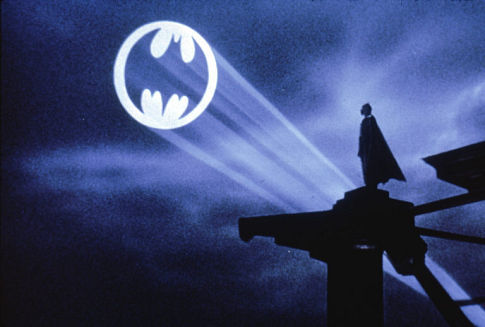
How many bats are dying in Wisconsin wind projects?
Three recent reports indicate the bat kill rates in Wisconsin wind projects are ten times the national average and the second highest in North America.
According to a recent post construction mortality report from We Energies the 88 turbines that make up the Blue Sky/ Green Field project have killed 7,000 bats during the first two years of operation.
Kill rates were the same in Dodge County's Cedar Ridge project and slightly higher in the Fond du lac County's Invenergy Forward project which is located alongside a national wildlife refuge.
Why Wisconsin bat mortality rates are so high in comparison to other parts of North America is unknown.
HOPE FOR STEMMING WIND ENERGY’S TOLL ON BATS
SOURCE: National Geographic News, news.nationalgeographic.com
September 15, 2010
By Andrew Curry,
Windmills—clean, quiet, simple and endlessly renewable—may be the ultimate icons of green energy. But after sundown, their whirling blades have an unintended consequence that researchers are just beginning to understand: They kill bats by the thousands.
Their greatest impact may be on the few species of bats that migrate. Bat experts say that the problem, which peaks during migration season from July to late September, may be worse than we know—but there’s cautious optimism, too. Proposed solutions include installing speakers that blast ultrasound to drive bats away and selectively shutting off windmills when bats are most active.
Killed by the Thousands
The first hint that wind farms were killing bats came from the Mountaineer Wind Energy Center on Backbone Mountain on the ridge of the Alleghenies near Thomas, West Virginia (map). Biologists looking for birds killed by the windmills in 2003 found nearly 400 dead hoary bats and eastern red-tailed bats. They soon concluded that the West Virginia site alone was killing between 1,400 and 4,000 bats a year.
In the years since, bat experts have raised the same alarm at other wind farms in the United States and Europe. Although there have also been concerns about windmills killing birds, the problem might be more severe for bats. For reasons no one fully understands, bat species that migrate over long distances seem to be attracted to the tall windmill towers. Perhaps they mistake them for trees, or want to hunt the insects that swarm around the tall, white structures. Maybe they’re simply curious.
When they fly too close, the nocturnal creatures are often killed by windmill blades, which, at the tips, can reach speeds of more than 200 mph. These massive wing-like blades strike some of the bats, while other bats are killed when they get sucked into the low-pressure zone behind the spinning blades. The low pressure can rupture bats’ tiny lungs and hearts.
As more and more wind energy installations are built, researchers are finding proportionately more dead bats. But one problem in gauging the full scope of the carnage is that researchers have almost no idea how many bats there are. Since they fly in the dark, it’s hard to count them the way that researchers count birds. Migratory bats tend to be solitary creatures, roosting in trees and crevices, so they can’t be counted easily when they’re asleep. And they’re too small—many weigh less than an ounce—to be tracked as birds sometimes are, with tags that can pinpoint their whereabouts through the use of GPS, or global positioning system.
“No one’s ever been able to actively track these bats. Before they started showing up under wind turbines, they were very infrequently observed,” says Paul Cryan, a bat expert working for the U.S. Geological Survey in Fort Collins, Colorado. “The logistics of following animals at night without knowing where they’re going and where they’re going to land is tremendously difficult.”
That uncertainty makes it difficult to tell what kind of impact windmills are having on the overall population—and how effective efforts to reduce the number of bat kills are. “We don’t know if we’ve mitigated the effect of the kills, or if we’re just delaying a population crash for 10 or 15 years,” says Ed Arnett, director of programs at Bat Conservation International in Austin, Texas. “But if you start adding it up over time, there’s just no way the animals can sustain this.”
Indeed, the many new wind projects across the United States—enough new windmills to power 2.4 million homes were installed last year—couldn’t have come at a worse time for bats.
Biologists are already overwhelmed trying to unravel a mysterious fungus known as white-nose syndrome that’s killing hundreds of thousands of cave-dwelling bats up and down the East Coast, with no cure in sight. “Those of us charged with the well-being of bats have really had the ground fall out from under us in the last 10 years,” Cryan says.
Renewable Energy Coexistence
But new research suggests that there may be hope on the horizon for protecting the migratory bats from windmill blades, at least. New methods for reducing bat kills are being tested in the field, and initial results are promising. One option is installing speaker systems on windmills to confuse and irritate bats with ultrasound noise, a frequency too high for human hearing. “It jams them, basically,” Arnett says. “We’re flooding them with white noise, which makes it uncomfortable and disorienting airspace to be in.”
So far, experimental speaker systems have reduced the number of bat fatalities 20 to 53 percent. But there are at least two problems with ultrasound systems, which cost $20,000 per experimental unit. First, modern windmill blades cover an area the length of a football field, too far to effectively project sound at that frequency. And the long-term consequences to bats and other wildlife of constant ultrasound are unclear.
Arnett has also experimented with an obvious solution: Turn off the windmills when bats are most active. For the past two years, Arnett has been working with Iberdrola Renewables, a large Spanish-owned wind energy provider, to selectively “feather,” or shut down, wind turbine at a wind farm in Garrett, Pennsylvania (map), when wind speeds are low. “It’s a time when we are not generating a whole lot of electricity to begin with,” says Iberdrola spokeswoman Jan Johnson.
In a forthcoming study, Arnett reports that during peak migration season, turning off windmills on the warm, late-summer nights bats like best—nights that don’t have that much wind to harness for energy, anyway—reduced annual bat fatalities by between 44 and 93 percent. Best of all, Arnett estimated that turning off windmills on the nights when bats were most active cost only .3 percent of the wind farm’s total annual power production. “We think there are ways to refine it so there are minimal impacts on the economics,” says John Anderson, siting policy director for the American Wind Energy Association.
The idea is gaining currency. Wind energy company Invenergy earlier this year agreed to time-of-year operating restrictions as part of a plan to protect the endangered migratory Indiana bat at a project it is now building in Greenbrier County, West Virginia. A federal judge temporarily blocked that project in response to a lawsuit by environmentalists; similar action over the risk to bats has been threatened over a new wind project in Maryland.
USGS bat expert Cryan says the Iberdrola study results are a relief to those who love the embattled bats. “Curtailment offers a great hope of minimizing bat fatalities,” he says. “Finally, this is something where we can come up with a solution to the problem.”
Note from the BPWI Research Nerd: The only reliable way to stop turbines from killing bats is to shut down the turbines at night.
9/15/10 Why are there so many complaints about living with wind turbine noise? AND What's going on with the wind siting rules? AND Can I get some maintenance for this turbine? What do you mean you're bankrupt? AND Mafia discovers a clean, green, dirty money laundering machine
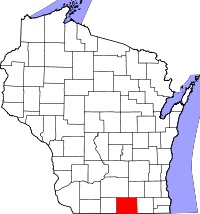 Wisconsin small business owner, Jim Bembinster, knows a lot about the complicated subject of wind turbine noise.
Wisconsin small business owner, Jim Bembinster, knows a lot about the complicated subject of wind turbine noise.
He spent 14 months focusing on noise issues as a member of the Large Turbine Wind Study Committee for the Town of Union (Rock County). He also helped author the Town of Union Large Wind Ordinance, considered by many to be the best in the state.
This ordinance has been adopted by local governments throughout Wisconsin, including five contiguous Towns in Rock County. Local governments from other states have used it for a model in creating their own ordinances.
The Town of Union Ordinance calls for a turbine noise limit of five decibels over the existing noise levels in the community.
The wind siting rules approved by the Public Service Commission, which preempt ordinances like the Town of Union’s, allow a nighttime noise level of 45dba—or an approximate increase of 20 decibels over normal rural noise limits.
Here, Mr. Bembinster explains how a 20 decibel increase will impact a rural community, and why masking turbine noise is so difficult.
The general rule for additional noise is this:
Adding 5dB is barely noticeable.
Adding 10dB is clearly heard— as it’s twice again as loud.
Adding 15 dB is very loud and this will become the dominant sound.
If ambient [existing] noise levels in a rural community are 25dB and turbine noise levels are at 45dB, there will be a problem.
The reason is the turbine, at 20dB louder, will be the dominant sound.
Although developers say noise from the turbine will be masked by other environmental sound, such as the wind blowing through the trees, a noise loud enough to cover the turbine must also be similar in character and at least 15 decibels louder, which puts it at least 60dB. This would be something like a the noise from a large truck going by or a Harley.
Also, in order to mask the sound, the character of the two types of sound must be the same.
Take the example of a baby crying.
If you were in a room with people who were all having a conversation at say 50dB and a baby started to cry at 40dB, the baby’s cry would be clearly heard over the conversation because of the difference of character and the tone of the noise it makes.
If the baby ramps up the crying to 50dB --the same sound level as the conversation in the room, the baby’s cry will become the dominant sound in the room even though both the crying and the conversation are at the same decibel level.
This is why people trapped in wind farms have trouble with the noise even though the turbine is within its noise limits of 45dB. Ambient sounds in a rural area can’t mask the sound of a turbine because the quality of the noise is so different, much like difference between a baby crying and adult conversation.
Another way to look at is how loud it would need to be inside your home so that a Harley could pass by unnoticed. That would be really loud, and not the best circumstance for sleeping.
There is nothing in a rural community that makes a sound similar enough to a wind turbine to mask it, except perhaps a jet or helicopter passing overhead, which is exactly what wind turbine noise is often compared to by those now living in wind projects.
SECOND STORY
WIND TURBINE RULE CAN BE REVISED, PANEL SAYS;
CHANGE WOULD ADDRESS POSSIBLE HEALTH EFFECTS
SOURCE: Green Bay Press Gazette, www.greenbaypressgazette.com
September 16 2010
By Tony Walter
One of the three members of the Public Service Commission who voted for the wind turbine siting rules last month noted in a letter to two top state lawmakers that the panel can revise the rules to address the potentially harmful health effects of the turbines.
“While I support the overall rule because it will promote the development of wind in Wisconsin, the rule fails to provide a much-needed safety net for people whose health declines because of a wind turbine located near their home,” Commissioner Lauren Azar wrote to legislative officials in an Aug. 31 letter.
“As new information becomes available, the Commission can revise this rule.”
Azar wasn’t available this week to comment on her proposal that would require wind turbine owners to purchase the home of anyone who can prove that the turbine has a significant adverse health outcome. An aide in her office said Azar’s letter speaks for itself.
Invenergy LLC wants to build a 100-turbine wind farm in the towns of Morrison, Glenmore, Wrightstown and Holland with turbines that produce more than 100-megawatts of energy. CH Shirley Wind LLC is erecting eight 20-megawatt turbines in Glenmore.
An Invenergy spokesman said last month that the company plans to resubmit its application for the Ledge Wind Farm project, noting that the health issue has been studied by numerous groups that concluded there is insufficient evidence to prove the turbines put people and animals at risk.
That proposal has prompted the creation of a Brown County citizens group speaking out against the wind turbine industry, arguing there hasn’t been sufficient study on health impacts.
Carl Kuehne, a member of the board of directors of the Brown County Citizens for Responsible Wind Energy, said the absence of definitive evidence on the health impact of wind turbines is reason enough to conduct more studies.
“No. 1, there is no need to move ahead today with more wind turbines in Wisconsin,” Kuehne said.
“The utilities are currently meeting the energy mandates set by the state government. So let’s study the situation. There’s certainly enough ad hoc evidence that wind turbines do have an impact on people and animals. Let’s study it and find out before we create more destruction on people. We have the opportunity.”
Last month, the PSC adopted rules for projects less than 100 megawatts. The rules can be altered by the state Legislature and lawmakers can ask the PSC to make changes. The issue has been assigned to the Assembly’s Committee on Energy and Utilities, which is led by Jim Soletski, D-Ashwaubenon, but no meeting date has been set.
THIRD STORY:
BANKRUPTCY RAISES WIND TURBINE ISSUES
September 16, 2010
By Bruce Burdett
PORTSMOUTH — With its wind turbine supplier bankrupt, Portsmouth is looking for a new company to provide the service it had believed was covered under the equipment’s original warranty.
Bankruptcy proceedings for Canadian firm AAER were completed in July. Pioneer Power Solutions bought some of AAER’s assets ”but appears unwilling to provide warranty coverage or operations and maintenance support,” Finance Director David Faucher wrote in a Sept. 8 memo to the town council.
Mr. Faucher and Assistant Town Planner Gary Crosby, who has overseen much of the town’s wind turbine effort, said they have met with representatives of Templeton Power and Light which has commissioned an AAER wind turbine generator similar to Portsmouth’s in hopes of partnering with the Massachusetts utility for a long term maintenance services contract.
But Mr. Faucher said Templeton is not yet at a point that it can enter into such a partnership.
So for now, Mr. Faucher recommended that the town council enter into an emergency one-year maintenance and service agreement with Solaya, a division of Lumus Constrictoon Inc. of Woburn, Mass. The council was scheduled to discuss and possibly vote on the agreement at its meeting on Wednesday this week (after the Times went to press).
The agreement would include two 6-month scheduled maintenance sessions (the first being this month), around-the-clock monitoring and unscheduled maintenance. At the end of the year, Mr. Faucher said he would ask the council to award a competitively bid contract for a three-year period.
The agreement with Solaya is “very detailed and describes the monitoring , warranty protction and maintenance services we have been seeking.”
Cost of the year’s basic service is $33,000, and the town would be charged additional fees for extra work.
FOURTH STORY
SOURCE: The Independent, www.independent.co.uk
MAFIA'S DIRTY MONEY LINKED TO CLEAN ENERGY
September 16 2010
By Michael Day in Milan,
After decades of drug-running, extortion and prostitution, the Mafia appears to have found a rather more ecological way of laundering their money: green power.
And if the assets of the Italian police’s latest target are any indication, the Mafia is embracing the renewable energy business with an enthusiasm that would make Al Gore look like a dilettante. The surprising revelation of organised crime’s new green streak came as Italian police said yesterday they had made the largest recorded seizure of mob assets – worth €1.5bn (£1.25bn) – from the Mafia-linked Sicilian businessman Vito Nicastri, who had vast holdings in alternative energy concerns, including wind farms.
Organised crime in Italy has previously been notorious for trading in environmental destruction – principally earning billions of euros by illegally dumping toxic waste. But most of the newly seized assets are in the form of land, property and bank accounts in Sicily, the home of Cosa Nostra, and in the neighbouring region of Calabria, the base of the rival ‘Ndrangheta crime syndicate.
Police said the operation was based on a 2,400-page investigative report and followed 54-year-old Mr Nicastri’s arrest last year. He has since been released without charge, and has denied wrongdoing. But General Antonio Girone, the head of the national anti-Mafia agency DIA, said that Mr Nicastri, known as “lord of the winds”, was linked to Matteo Messina Denaro, the fugitive believed to be the Sicilian Mafia’s “boss of bosses”.
Senator Costantino Garraffa, of the parliamentary anti-Mafia committee, said the Mafia was trying to break into the “new economy” of alternative energy as it sought to launder money earned from crime. The seizure of Mr Nicastri’s assets “confirms the interest that organised crime has in renewable energy, which several annual reports on environmental issues have already stressed,” added Beppe Ruggiero, an official with the anti-Mafia association Libera.
Generous subsidies have led to rapid growth in wind power in Italy in recent years. Mr Ruggiero said: “It is very important for this sector to stay far from Mafia activities.” However, he stressed the need for renewable energy to develop in Italy’s poorer South. “Investment in renewable energy should not be discouraged,” he said, adding that the nuclear alternative would be “a losing choice”.
Recent estimates suggest the total annual turnover of Italy’s main organised crime groups is around €100bn (£83bn), or 7 per cent of GDP. Officials, including the Bank of Italy governor, Mario Draghi, have argued that organised crime has perpetuated poverty in the south of the country.
10/14/10 On being a red square in a yellow circle: A wind siting council member weighs in on the real cost of Wisconsin wind farms AND Wind Turbines Too Loud? Sorry Charlie, ain't a lot we can do for you now.


HOW MANY RESIDENTS WILL BE AFFECTED BY THE NEW WIND SITING RULES?

The red squares in the yellow circles on the map above represent non-participating homes in the WeEnergies Glacier Hills wind project currently under construction in Columbia County.
The larger red dots are the turbine locations. [Scroll down to see more detailed maps.]
The new wind rules adopted by the Public Service Commission have the same setbacks from homes as were used for this project.
One difference is the PSC required WeEnergies to offer to buy two homes in the project because seven turbines were to be located within half a mile.
The new rules do not include this sort of protection. Chairman Eric Callisto said by law homeowners have the right to sue the wind developer/owner and he felt that was all the protection they needed.
Although Wisconsin wind farm residents who have been forced to try to sell their homes because of turbine noise and shadow flicker have found no buyers, local wind developers say 400 to 500 foot tall wind turbines located less than 1500 feet a home have no impact on property values.
[CLICK HERE to watch Wisconsin Eye video: During the panel discussion, WPPI vice president Dan Ebert and WeEnergy's head of wind development Andy Hesselbach explain why turbines do not affect property value. ]
Or CLICK HERE to link directly to the Wisconsin Eye 'Newsmakers' feature "Future of Wind Energy"
Developers also say Wind energy is the cheapest way to get renewable energy and cite surveys which indicate stong public support for wind power.
Wind siting council member and Wisconsin realtor Tom Meyer weighs in on the matter.
This is not a question of whether or not people like, or favor "wind" as the lobbyists try to argue. Everyone likes wind, sun, water, earth.
The issue is this: The total cost of generating energy by the use of 400 and 500 foot tall turbines in Wisconsin’s rural communities.
Developers admit that they cannot get investors, who are primarily foreign investors, to put their money up unless the costs of access to the land are depressed.
To get the biggest area to install the highest number of 400 to 500 foot tall turbines, the developer needs to have the greatest access to the most land and compensate the fewest people with the least dollars.
The developer does not need your land, he needs to get one foot [away] from your land.
Every foot the developer is made to move away from a landowner whom he does not have to compensate, adds cost to the developer and reduces the bottom line to investors.
Every dollar spent to gain access to the right to disturbing the peace of a landowner reduces the bottom line.
For wind turbines to be profitable, the industry could improve the technology or depress the cost of access to the land.
By their actions, they prove they believe depressing land costs is more favorable than investing in improving the technology.
Their answer to improved technology is taller and more intrusive. That's not a real solution.
If the turbine can't produce energy without imposing on neighbors, there is no reason to spoil the earth, and threaten the water, and block the sun, to catch the wind.
-Tom Meyer
Wisconsin Wind Siting Council Member
NOTE: Tom Meyer was one of the authors of the minority report from the wind siting council. The report details why some council members strongly disagree with the recommendations sent forth to the Public Service Commission.
CLICK HERE to download pictures of homes in Wisconsin wind projects.
Below, detail maps of non-participating residences in WeEnergies Glacier Hills Project

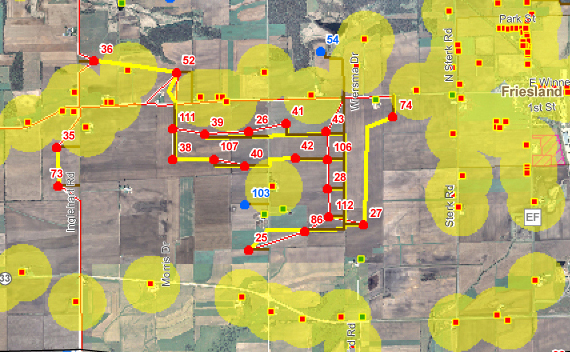
NOTE FROM THE BPWI RESEARCH NERD:
The project mentioned below was sited with the same setbacks and noise limits used to site the We Energies Glacier Hills project. (Detail maps above)
NO EASY SOLUTION TO WIND TURBINE PROBLEM
The Associated Press
VINALHAVEN, Maine (AP) -- The CEO of the electric cooperative that installed wind turbines on Maine's Vinalhaven island says there's disagreement over data suggesting they're too noisy. Fox Island Wind CEO George Baker says his experts dispute the findings of a Department of Environmental Protection consultant who says the turbines violate nighttime noise limits. State law sets a 45-decibel limit. Baker says his experts believe it was ambient noise from wind rustling through trees that exceeded 45 decibels, not the turbines themselves. Baker says it'll be a difficult issue to resolve. He told The Associated Press on Tuesday that slowing the turbine blades to lower the noise level by a couple of decibels may not make appease critics. And lowering it further could hurt the economic viability of the project.
